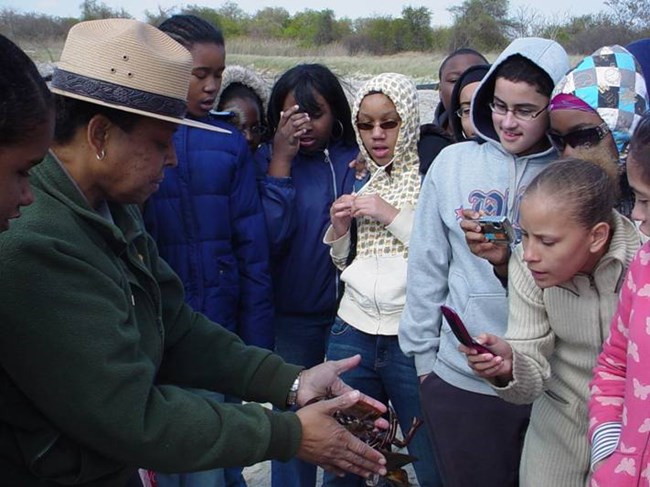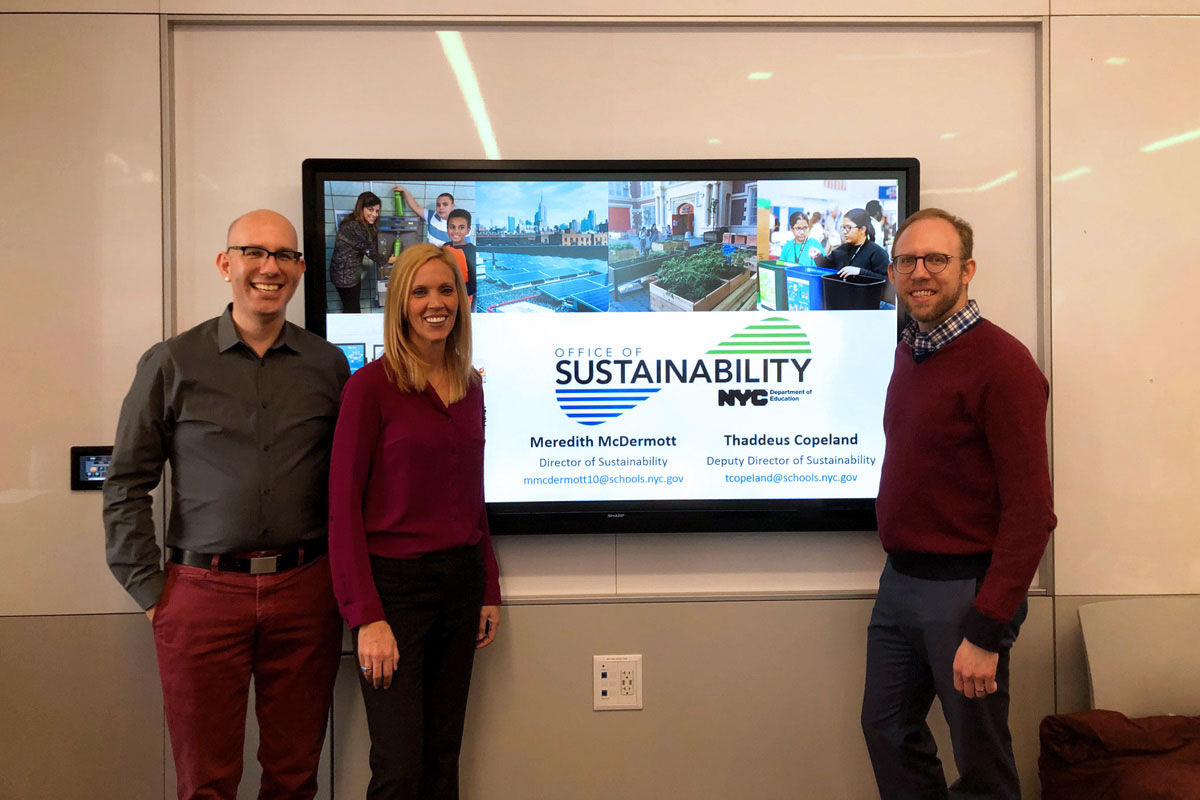The course is titled “Introduction to Environmental and Sustainability Education,” and in late February it more than lived up to that billing when the professor, Oren Pizmony-Levy, brought two guest speakers to class: Meredith McDermott and Thaddeus T. Copeland, Director and Deputy Director, respectively, of Sustainability at the New York City Department of Education (NYCDOE).
“Partnerships are huge,” Copeland told the class. “There’s no better partnership than what we have here with Teachers College, in terms of strategy and data. It has really been useful for us in looking at the big picture and [having] someone else helping us move this ship.”
Teachers College is one of 40 organizations and agencies working with the DOE on sustainability issues. The College supports school sustainability coordinators and measures their effectiveness in promoting a whole-school approach that addresses facilities issues, such as recycling and reducing energy use, and introduces concepts such as climate change and renewable energy sources into classroom curricula.
I think one of the main messages here is that technology and infrastructure are not enough. We need communication and community-building work to do, in order to make sustainability happen.
—Oren Pizmony-Levy
The partnership with the DOE is part of the Initiative for Sustainability Futures, an inter-departmental collaboration of Teachers College faculty, students, and staff across the College who are interested in sustainability. Pizmony-Levy’s class is studying the global environmental and sustainability education movement and the ways in which different educational systems around the world engage with this movement. The DOE presentation gave students a first-hand view of efforts in the New York City school system, the largest in the country.
In 2009, the DOE established the Office of Sustainability to ensure compliance with the plan across all of its schools. The mandate also required each school to designate a school-based sustainability coordinator (originally called recycling coordinator), and to survey the coordinators annually.

(Photo courtesy the National Parks Service)
With 1,400 buildings under its control – a large portion of City-owned properties – and 130 million square feet of facilities space, NYCDOE is critical to the success of the city’s overall sustainability plan to send zero waste to landfills by 2030 and achieve carbon neutrality by 2050.
In 2015, Teachers College began collaborating with the Office of Sustainability to enhance the annual school Sustainability Plan, in which schools make commitments to achieve sustainability actions throughout the year. Data from the plan, analyzed by Pizmony-Levy and his students, revealed several new opportunities for the Office of Sustainability to better support Sustainability Coordinators, including more support for forming school-based green teams and interest in alternative training formats. As a result, the College created content for a series of webinars, including one specifically on green teams.
Pizmony-Levy said the Teachers College team also is “using cutting-edge social science methodologies” to survey the Coordinators and analyze how well the City’s schools are progressing toward their environmental goals. “We help them professionalize the collection of data. We can spot patterns, trends and gaps in the efforts.”
There’s no better partnership than what we have here with Teachers College, in terms of strategy and data. It has really been useful for us in looking at the big picture and [having] someone else helping us move this ship.
—Thaddeus T. Copeland
According to DOE policy, Sustainability Coordinators are existing school staff members who take on environmental duties without extra compensation. About 88 percent of DOE schools have at least one Coordinator on site. Teachers College research found that among all sustainability coordinators, 44 percent identified as teachers, and of those, nearly half are science teachers. About 30 percent are assistant principals, and 26 percent have other jobs ranging from guidance counselors to parent coordinators.
The surveys showed a high interest among coordinators in connecting with their peers in other schools to share information and best practices. Pizmony-Levy and his students plotted those networking requests on a city map with lines from one school to another. The map shows “hub” schools, where multiple coordinators expressed an interest in forming partnerships and sharing best practices.
“We’re exploring social networks as a means for developing professional capital and amplifying good practices,” he said. “I think one of the main messages here is that technology and infrastructure are not enough. We need communication and community-building work to do, in order to make sustainability happen.”
McDermott said New York City’s plan, while not unique, and can serve as a model for other cities because it is tied to United Nations global sustainability goals that are widely applicable. Also, she said, New York City is so diverse that its work can be applied in many different settings, from big cities to small towns, and in different places across the globe.
Out of the 200 largest school districts in the country, 54 have programs similar to New York City, Pizmony-Levy said. One of his students is studying what makes school systems successful at environmental and sustainability education. The New York City case suggests that mayoral control is an important factor, making it easier to centralize and coordinate planning and execution.
Even as the threat of global climate change looms larger, the school surveys confirm that school-based efforts are driven not as much by global concerns as by interest in environmental issues in local schools. Students, teachers and staff want to know what they can do on their own campuses to reduce waste and energy consumption, Pizmony-Levy said.
Interest is growing among K-12 school districts to team up with university-based academic programs. At the same time, the number of higher education students interested in internships with local districts and capstone projects “has gone way up,” Pizmony-Levy said.
“Through our partnership with the DOE, we’re working to quantify and forge that interest into school-level programs that successfully reduce the carbon footprint of local schools and educate the next generation of environmental scientists and activists.”
